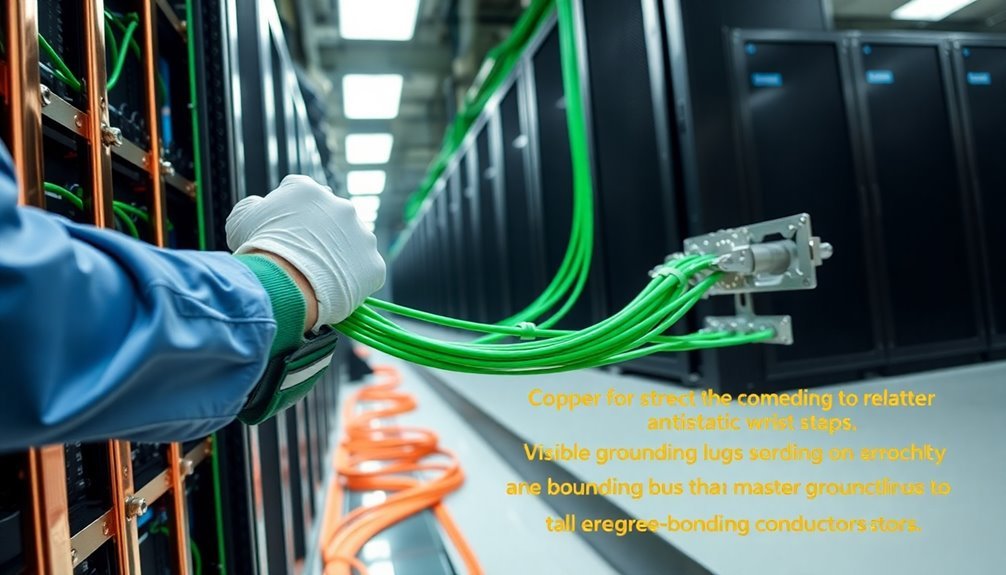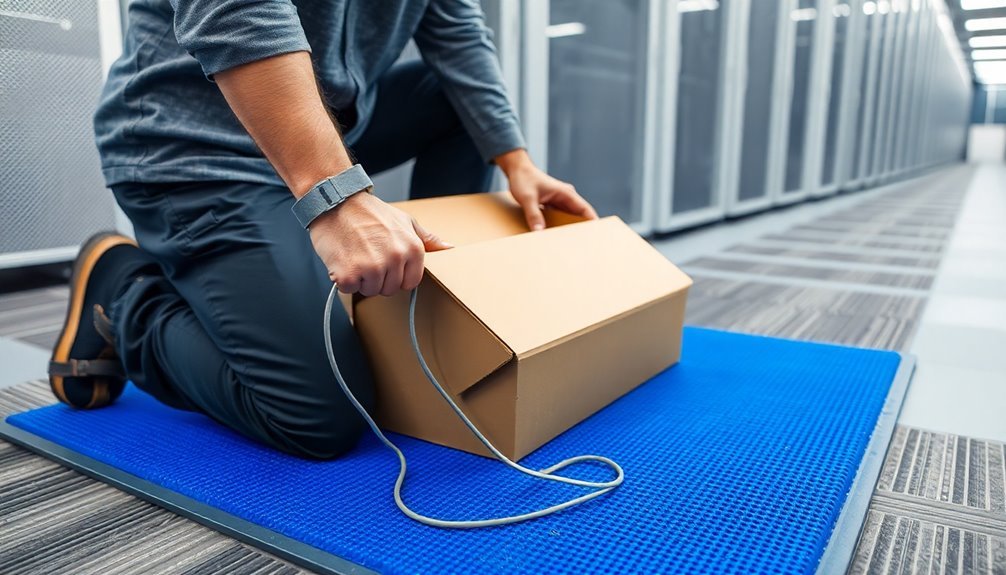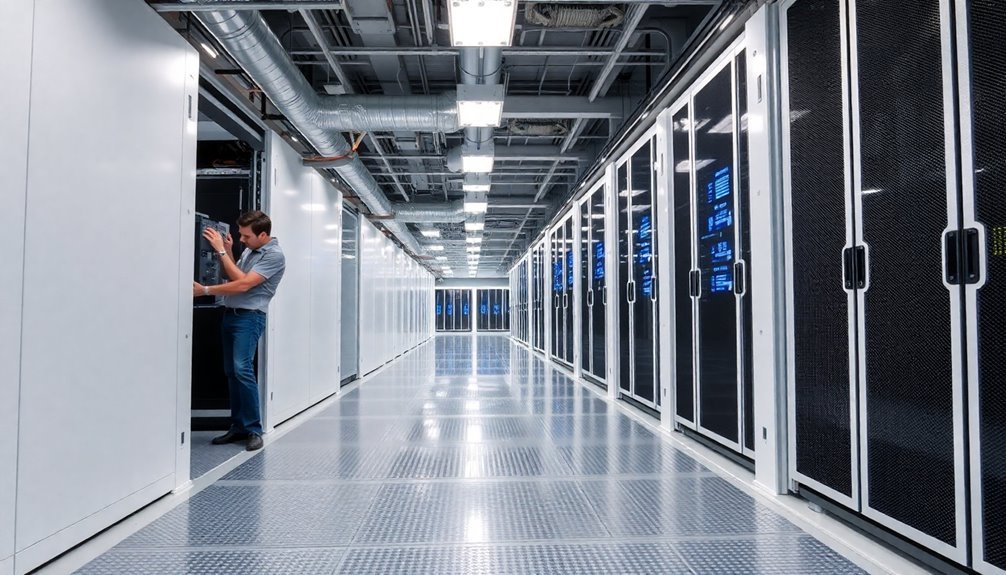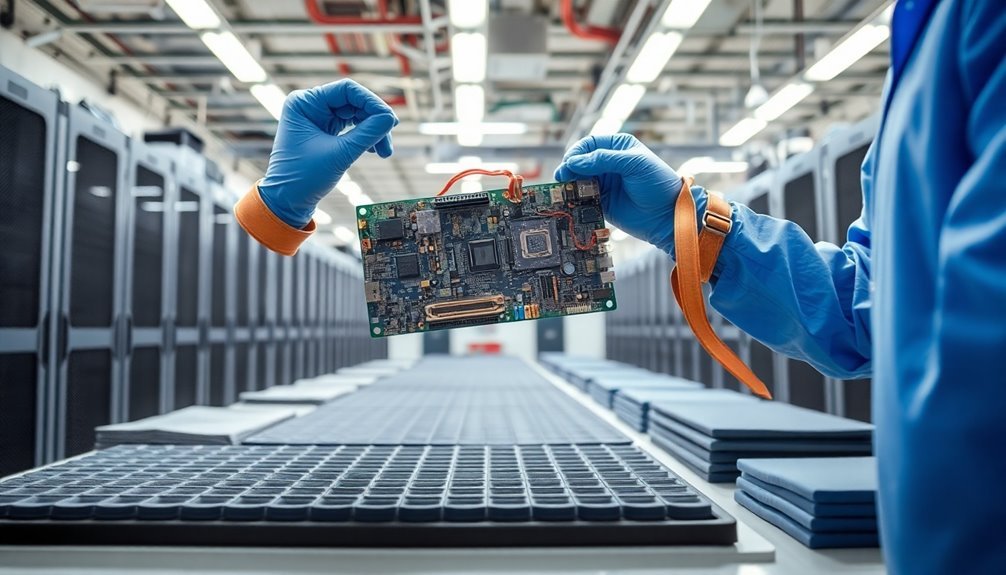To protect your server during installation, you'll need five essential safeguards. First, establish proper grounding by connecting all metal components to a reliable grounding system. Second, create a static-safe workspace with humidity levels between 40-60% and temperatures between 68-72°F. Third, use ESD mats and appropriate flooring to prevent electrostatic discharge damage. Fourth, wear personal protective equipment including ESD wrist straps, safety glasses, and protective gloves. Fifth, implement environmental controls with precise temperature and humidity monitoring. These fundamentals form the foundation for a deeper understanding of server protection protocols.
Grounding Equipment and Materials

Establishing proper grounding is critical when installing server equipment to protect both hardware and personnel. You'll need to connect all metal frames and enclosures to a reliable grounding system that safely redirects stray electrical currents to the ground.
Before installing any other cabling, verify you've implemented proper grounding methods for racks, cabinets, PDUs, and switches. Using a low-impedance path through the grounding system helps minimize signal interference between equipment.
Your grounding system should include a Master Grounding Bus Bar (MGB) as the primary connection point, with smaller rack grounding bus bars connected to it.
Install copper or copper-clad steel ground rods around your data center's perimeter, and consider adding a continuous copper ground ring for enhanced efficiency. If you're working in areas with poor soil conductivity, you'll need supplemental ground rods.
To comply with ANSI/TIA-942 standards, make sure you're bonding all metal components properly. You'll reduce risks of electrical shock, equipment damage, and electromagnetic interference by following these protocols.
Focus on proper cable management and maintain consistent connections between your equipment and the grounding system. This systematic approach guarantees optimal protection against voltage fluctuations and electrical surges while maintaining high system availability.
Static-Safe Work Zone Setup
Beyond proper grounding, a well-designed static-safe work zone forms your next line of defense against equipment damage. You'll need to control both environmental conditions and personal equipment to create a truly static-safe workspace.
Start by maintaining humidity levels between 40% and 60%, and keep temperatures at 68°F to 72°F. You'll want to outfit your team with static-dissipative clothing, including ESD wrist straps, heel straps, and appropriate footwear. Verify your workstations feature static-dissipative surfaces and properly grounded tools. Using an antistatic wrist strap connected to the chassis metal surface is essential when handling any system components.
| Element | Requirement | Monitoring Method |
|---|---|---|
| Humidity | 40-60% | Digital hygrometer |
| Temperature | 68-72°F | Thermostat |
| Flooring | Static-dissipative | Resistance testing |
| Personnel | ESD gear | Daily checklist |
Don't forget to implement thorough training for all personnel working in the static-safe zone. Your team should understand proper ESD prevention techniques and safety protocols. Regular audits will help maintain compliance and identify potential issues before they cause damage. Keep workstations clean using static-dissipative cleaning products, and clearly label all static-sensitive areas to maintain awareness throughout the workspace.
ESD Mats and Flooring

A reliable ESD mat forms the cornerstone of your static-safe server installation workspace. You'll find these mats available in various configurations, from single-layer vinyl to three-layer designs with carbon cores. Whether you choose conductive or dissipative mats, they'll protect your sensitive server components from damaging static discharge.
To maximize protection, you'll need to properly ground your ESD mat using metal snaps and ground cords connected to Earth Bonding Points. Make certain you're maintaining good contact with the mat while working, and always use it in conjunction with ESD wrist straps for complete protection. One grounding connection is required for every 1000 square feet of protective surface.
For larger server rooms, consider installing ESD flooring. You'll want to work with local contractors who can properly test the subfloor and apply conductive adhesives. These floors provide thorough static protection across your entire workspace.
When selecting your ESD mat, you can opt for models with anti-fatigue features if you'll be standing for extended periods. Look for IEC-certified products to guarantee reliable protection. Remember, you can connect multiple mats to create larger workspaces or expand your protected area as needed.
Personal Protection Equipment Requirements
Proper personal protective equipment (PPE) serves as your first line of defense during server installation work. You'll need to verify all your safety gear meets regulatory standards before beginning any installation tasks.
Make sure to lift with mechanical assistance whenever possible, as manually lifting servers can lead to injury. Start by wearing protective gloves to shield your hands from sharp server components and chassis edges. Don't forget to put on safety glasses to protect your eyes from potential debris during the installation process.
If you have long hair, you must tie it back securely to prevent it from getting caught in server fans or other moving parts. Similarly, avoid wearing loose clothing that could snag on equipment or get pulled into ventilation systems.
When handling server components, you'll need to wear an anti-static wrist strap to prevent electrostatic discharge damage. For hot components like processors and heat sinks, use appropriate thermal protection.
Before starting any maintenance work, you'll need to power down the server and disconnect all power sources. Remember to use proper grounding techniques and manage your cables effectively to prevent electrical hazards.
Don't attempt to service power supplies or components marked as non-serviceable, as these require specialized handling by qualified technicians.
Environmental Controls Implementation

Environmental controls form the backbone of server protection during installation and operation. You'll need to implement precise temperature controls to maintain the server room between 68°F and 72°F, preventing potential hardware damage and data loss.
It's essential to monitor humidity levels, keeping them between 40% and 60% to avoid electrostatic discharge or condensation issues.
You should deploy multiple sensors throughout the room to create a thorough monitoring network. Connect these sensors to your DCIM software for automated data collection and real-time alerts. Make sure you're setting appropriate thresholds that'll trigger notifications through SNMP traps, emails, or SMS when conditions deviate from acceptable ranges. Installing leak detection sensors can provide immediate alerts if water threatens your equipment.
Don't forget to integrate physical security controls with your environmental monitoring system. You'll want to install door sensors, motion detectors, and access control systems to prevent unauthorized entry.
Keep the server room clean and well-maintained to reduce dust accumulation. Store historical data from your monitoring systems to analyze trends and improve conditions over time.
Frequently Asked Questions
How Often Should Server Protection Methods Be Updated After Initial Installation?
You'll need to update server protection daily for virus patterns, monthly for system patches, quarterly for virtual appliances, and every six months for firmware. Apply critical security patches immediately when they're released.
Can Virtual Servers Benefit From Physical Server Protection Methods?
Yes, you'll find virtual servers can benefit from physical protection methods. They're still dependent on physical hardware, so implementing security measures like restricted access, environmental controls, and power redundancy enhances overall security.
What Level of Encryption Is Recommended for Protecting Server Data?
You'll want to implement high encryption with AES-256 for your server data, using FIPS-compliant methods and TLS protocols. Don't forget full disk encryption to guarantee thorough protection of all stored information.
Should Backup Servers Follow the Same Protection Protocols as Primary Servers?
No, you'll need stricter protocols for backup servers. They require enhanced isolation, air-gapped storage, multi-factor authentication, and diverse backup repositories since they're prime targets for attackers seeking to compromise data recovery capabilities.
How Do Cloud Environments Affect Traditional Server Protection Methods?
Cloud environments render many traditional server protection methods less effective since you'll need dynamic security, shared responsibility models, and scalable solutions instead of static perimeter defenses to properly protect cloud-based infrastructure.
In Summary
You'll greatly reduce the risk of damage to your servers during installation by following these essential protection methods. Properly ground your equipment, maintain a static-safe workspace, use ESD mats, wear appropriate PPE, and control environmental conditions. Don't skip these critical steps – they're your best defense against costly hardware failures and data loss caused by electrostatic discharge and improper handling.





Leave a Reply